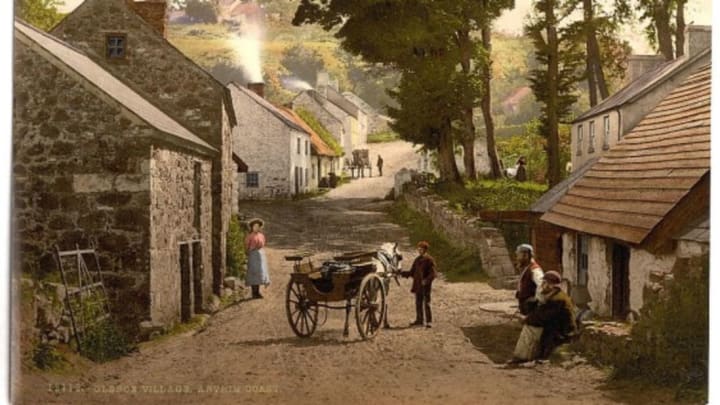There's a lot more to the Emerald Isle than the supposed World’s Greatest Snake Exterminator. Need some proof? Just check out these photochrom prints of Ireland taken between 1890 and 1900 and organized by county, courtesy of the Library of Congress.
County Antrim

While Belfast’s main shopping district was a popular target of IRA attacks in the seventies and eighties, most of the buildings in this image are still standing after all this time.

With its picturesque trees and waterfalls, Glenariff Forest Park is quite a popular tourist destination these days. The area is nicknamed “Queen of the Glens”—the largest and most beautiful glen in the county.

Amazingly, this rope bridge linking Carrick Island to the mainland is still in use. It has become a major tourist attraction. To be fair, though, it has been redesigned and improved over the years to make it safer.

While the beaches of Portrush are still a draw for tourists, the town is now also known for its dance clubs and Barry’s Amusements, the largest amusement park in Northern Ireland.

You might recognize this famous icon from the cover of Led Zeppelin’s Houses of the Holy. The weird natural design is the result of an ancient volcanic eruption. The hot lava cooled so fast that it created deep, giant cracks that eventually broke into the columns you see today.
County Wicklow

The River Avoca flows only through the County Wicklow, where it starts off as two distinct rivers and then flows together at one point, known as the Vale of Avoca. This vale is located inside the town of Avoca, pictured here.

The entire center of County Wicklow is made up of the Wicklow Mountains, which are naturally adorned with a number of rivers and stunning waterfalls like this one. This particular waterfall no longer exists since the Poulaphouca Reservoir was completed in 1940.

Up until the mid-1700s, Bray was a sleepy fishing village, but as the people of Dublin started to seek sanctuary outside the crowded city, the town’s population grew quickly. By the mid-1800s the town had become the largest seaside resort in the country. These days, Bray is home to the country's only dedicated film studios, Ardmore Studios. The company has produced such classics as Excalibur and Braveheart.

The River Dargle is named An Deargail in Gaelic, which translates to "little red spot." While it’s not obvious in this picture, the name is a reference to the fact that most rocks in the river are tinted red.

While this small town only has a population of around 2,500, its gorgeous scenery (the town is located at the foot of the Wicklow Mountains) and close proximity to Bray make it a popular tourist destination year round.
County Dublin
Shelbourne Hotel, Dublin

This beautiful hotel opened in 1824 and is still open for business, currently operating under the banner of Marriott International. The hotel even played an important role in Irish history. In 1922, it served as the meeting place for the creators of the Irish Constitution and room 112, where it was drafted, is now fittingly known as The Constitution Room.

Officially known as the Cathedral of the Blessed Virgin Mary and St. Patrick, this icon of Ireland was founded all the way back in 1191 and now serves as the National Cathedral of Ireland. It also holds the record for the tallest church in Ireland, boasting a spire that stands 140 feet tall.

No, this isn’t an early picture of the Washington Monument. The obelisk in the background is instead the Wellington Monument, found in Phoenix Park, Dublin. The obelisk is the tallest in Europe and is dedicated to the great deeds of Arthur Wellesley, 1st Duke of Wellington.
County Cork

While this particular hotel may no longer be in business, the small town of Glengarriff (population 800) is still a popular tourist destination providing seaside views adorned with paired high mountain peaks and quaint peat bogs scattered across the town.

The town is named for the Glengarriff Forest, Gleann Garbh in Gaelic, which means "rough glen.” The forest is indeed home to a rough glen and some of the oldest oak and birch groves left in Ireland.

Blackrock Castle was originally constructed as a fort intended to keep away pirates and other potential threats. While a few remains of the original building still stand, most of it was destroyed in a fire in 1827 and replaced with the current structure that was completed in 1829. While the castle was used for a variety of purposes throughout the ages, it now serves as Ireland’s first fully interactive astronomy center, which is open to the public.
County Waterford

The Gaelic name for this city is Dún Garbháin, which translates to "Garbhan's fort", referring to Saint Garbhan who founded a church there in the seventh century. These days, Dungarven is the administrative center of County Waterford.
The Quays, Waterford

Waterford is the oldest city in all of Ireland, established back in 914. One thousand years later and the city is still the fifth largest in the country. Of course, these days, Waterford is best known for its crystal. Sadly, Waterford Crystal shut down its factory in the town in 2009 after operating in the town for over 225 years. Thanks to the Waterford City Council and Waterford Chamber of Commerce, though, guests can now visit The Waterford Crystal Visitor Center instead.
County Kerry

This stunning castle looks largely the same now as it did back when this picture was taken, despite the recent renovations that have allowed it to become open to the public. Back in the late 1400s, this castle was one of the strongest military posts in the country. In fact, during the Irish Confederate Wars of the 1600s, it was one of the last castles to surrender; the leader of the battle only did so after the castle was attacked via water—something no one inside the stronghold saw coming.
